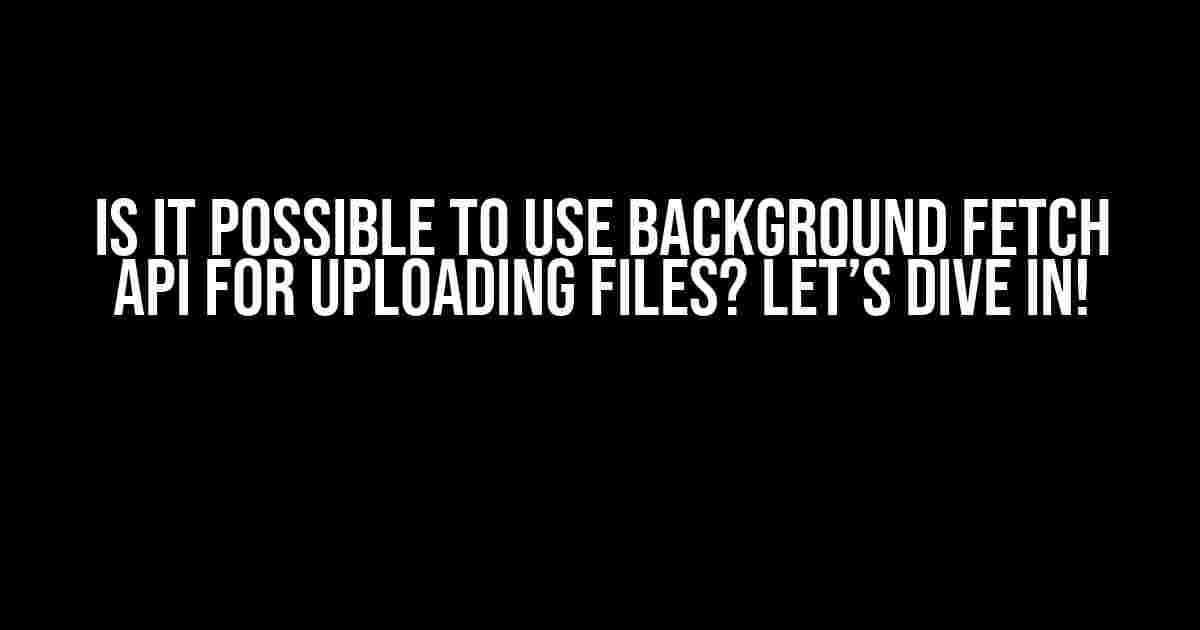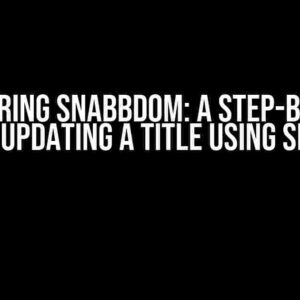When it comes to uploading files, developers often face the challenge of providing a seamless user experience while ensuring that the upload process doesn’t interrupt the user’s workflow. One approach to achieving this is by using the Background Fetch API, a relatively new API that allows web applications to request access to the user’s network and system resources in the background. But the question remains: can we use Background Fetch API for uploading files?
What is Background Fetch API?
Before we dive into the possibility of using Background Fetch API for uploading files, let’s quickly understand what it is. Background Fetch API is a new web API that allows web applications to request access to the user’s network and system resources in the background, enabling them to perform tasks like fetching resources, sending analytics data, or even uploading files without interrupting the user’s workflow.
// Example code to request background fetch
navigator.serviceWorker.ready.then((registration) => {
registration.backgroundFetch.fetch('fetch-images', {
request: new Request('https://example.com/image.jpg'),
downloadTotalBytes: 1024,
}).then((fetch) => {
console.log('Background fetch started:', fetch);
});
});
The Possibility of Using Background Fetch API for Uploading Files
Now, let’s get to the million-dollar question: can we use Background Fetch API for uploading files? The short answer is yes, but with some caveats. While the API is capable of handling file uploads, there are some limitations and considerations you should be aware of.
Uploading Files using Background Fetch API: The Good
- Seamless user experience: Background Fetch API allows you to upload files in the background, providing a seamless user experience without interrupting the user’s workflow.
- Improved performance: By offloading the upload process to the background, you can improve the overall performance of your web application.
- Flexibility: Background Fetch API provides flexibility in terms of upload sizes, formats, and types, allowing you to adapt to various use cases.
Uploading Files using Background Fetch API: The Not-So-Good
- Limited browser support: Background Fetch API is still a relatively new API, and its browser support is limited. Currently, only Chrome and Opera support it.
- File size limitations: Background Fetch API has file size limitations, which can be a constraint for uploading large files.
- Security considerations: Uploading files using Background Fetch API requires careful consideration of security implications, such as authentication, authorization, and data encryption.
How to Use Background Fetch API for Uploading Files
If you’re still interested in using Background Fetch API for uploading files, here’s a step-by-step guide to get you started:
-
Check browser support: Before implementing Background Fetch API, ensure that your target browser supports it. You can use the following code to check for support:
if ('backgroundFetch' in navigator.serviceWorker) {
console.log('Background Fetch API is supported!');
} else {
console.log('Background Fetch API is not supported!');
}
-
Register a service worker: You’ll need to register a service worker to manage the background fetch requests. Create a new JavaScript file and add the following code:
navigator.serviceWorker.register('worker.js')
.then((registration) => {
console.log('Service worker registered:', registration);
});
-
Handle file uploads: In your service worker, handle file uploads using the following code:
self.addEventListener('fetch', (event) => {
if (event.request.method === 'POST' && event.request.body) {
const fileUploadRequest = event.request.clone();
const file = event.request.body.get('file');// Upload the file using Background Fetch API
event.waitUntil(
self.registration.backgroundFetch.fetch('upload-file', {
request: fileUploadRequest,
uploadTotalBytes: file.size,
})
);
}
});
-
Monitor upload progress: To monitor upload progress, you can use the following code:
self.addEventListener('backgroundfetchprogress', (event) => {
const progress = event.fetch.progress;
console.log(`Upload progress: ${progress.downloadedBytes} bytes`);
});
Conclusion
In conclusion, while Background Fetch API can be used for uploading files, it’s essential to be aware of its limitations and considerations. By following the steps outlined in this article, you can successfully implement Background Fetch API for uploading files and provide a seamless user experience. However, don’t forget to weigh the pros and cons before deciding to use this API.
| Advantage | Disadvantage |
|---|---|
| Seamless user experience | Limited browser support |
| Improved performance | File size limitations |
| Flexibility | Security considerations |
So, is it possible to use Background Fetch API for uploading files? Absolutely! But it’s crucial to carefully evaluate the trade-offs and ensure that this API aligns with your project’s requirements.
Here are 5 Questions and Answers about “Is it possible to use Background Fetch Api for uploading file..?”
Frequently Asked Question
Get the scoop on using Background Fetch API for uploading files!
Can I use Background Fetch API for uploading files?
While Background Fetch API is perfect for downloading files, it’s not suitable for uploading files. Its primary purpose is to fetch resources in the background, not to send data to a server.
Why can’t I use Background Fetch API for uploading files?
The main reason is that Background Fetch API is designed for reading data, not writing data. It doesn’t provide a way to send data to a server, which is necessary for uploading files.
Are there any alternatives for uploading files in the background?
Yes, there are! You can use the Fetch API with the `keepalive` flag or the `service worker` API to upload files in the background. These APIs allow you to send data to a server while the user continues to interact with your application.
Can I use Background Fetch API for uploading small files?
Even if you’re uploading small files, Background Fetch API is not the right choice. It’s still designed for downloading resources, and it’s not intended for uploading data. Stick to alternatives like the Fetch API or service worker API for uploading files, regardless of their size.
Will Background Fetch API ever support uploading files?
There’s no official word on whether Background Fetch API will add support for uploading files in the future. For now, it’s best to rely on alternative APIs for uploading files, and keep an eye on the latest developments in the world of web APIs!





